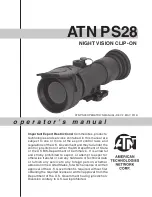
Celestar Manual
Celestial Observing
51
Seeing conditions refers to the stability of the atmosphere and directly effects the amount of fine detail seen
in extended objects. The air in our atmosphere acts as a lens which bends and distorts incoming light rays.
The amount of bending depends on air density. Varying temperature layers have different densities and,
therefore, bend light differently. Light rays from the same object arrive slightly displaced creating an
imperfect or smeared image. These atmospheric disturbances vary from time-to-time and place-to-place.
The size of the air parcels compared to your aperture determines the "seeing" quality. Under good seeing
conditions, fine detail is visible on the brighter planets like Jupiter and Mars, and stars are pinpoint images.
Under poor seeing conditions, images are blurred and stars appear as blobs. Seeing conditions are rated on
a five-point scale where one is the worst and five is the best (see Figure 7-4). Seeing conditions can be
classified in one of three categories which are based on the cause.
Type 1 seeing conditions are characterized by rapid changes in the image seen through the telescope.
Extended objects, like the Moon, appear to shimmer while point sources (i.e., stars) appear double. Type 1
seeing is caused by currents within or very close to the telescope tube. These currents could be caused by a
telescope that has not reached thermal equilibrium with the outdoor surroundings, heat waves from people
standing near the telescope, or heated dew caps. To avoid the problems associated with Type 1 seeing,
allow your telescope approximately 45 minutes to reach thermal equilibrium. Once adjusted to the outdoor
temperature, don't touch the telescope tube with your hands. If observing with others, make sure no one
stands in front of or directly below the telescope tube.
The images produced by Type 2 seeing conditions don't move as quickly as those produced by Type 1
conditions, but the images are quite blurry. Fine detail is lost and the contrast is low for extended objects.
Stars are spread out and not sharp. The source of Type 2 seeing is the lower atmosphere, most likely heat
waves from the ground or buildings. To avoid the problems associated with Type 2 seeing, select a good
observing site. Look for broad hill tops or open grassy fields. Stable thermal conditions found near lakes
and atmospheric inversions also tend to produce good seeing. Avoid sites that overlook asphalt parking
lots or plowed fields. Stay away from valleys and shorelines. If you can't get a better location, wait until
the early morning hours when the surroundings are uniformly cool and the seeing is generally better.
Type 3 seeing conditions are characterized by fast ripples, but sharp images. In extended objects fine detail
is visible, but the images shift around the field. Stars are crisp points, but they shift small distances rapidly
around the field. The cause of type 3 seeing is turbulence in the upper atmosphere which means the
observer has less control over it. However, the effects of Type 3 seeing are generally less pronounced than
the other two types. You can never really avoid Type 3 seeing. Your best bet is to wait until moments of
steadiness. If the seeing is extremely bad, pack up and wait for a better night.
The conditions described here apply to both visual and photographic observations.
Figure 7-3











































